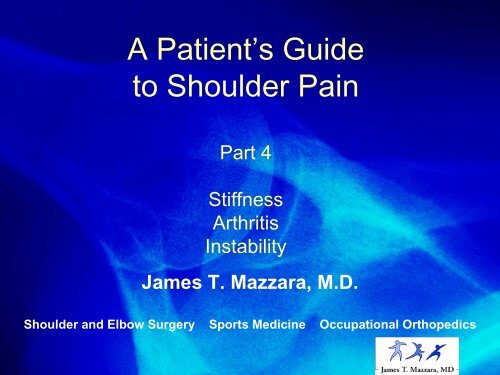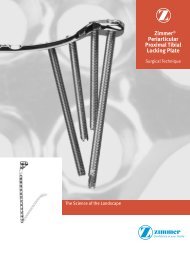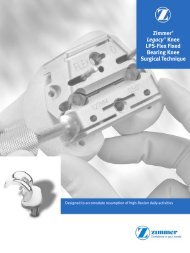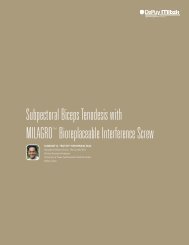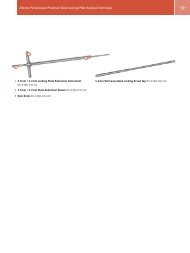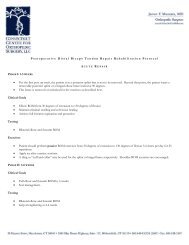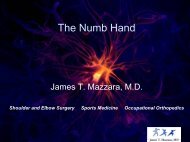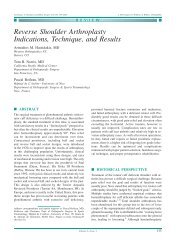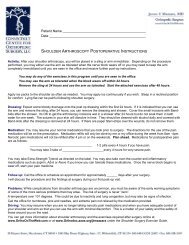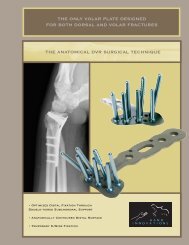A Patient's Guide to Shoulder Pain
A Patient's Guide to Shoulder Pain
A Patient's Guide to Shoulder Pain
Create successful ePaper yourself
Turn your PDF publications into a flip-book with our unique Google optimized e-Paper software.
A Patient’s <strong>Guide</strong><br />
<strong>to</strong> <strong>Shoulder</strong> <strong>Pain</strong><br />
Part 4<br />
Stiffness<br />
Arthritis<br />
Instability<br />
James T. Mazzara, M.D.<br />
<strong>Shoulder</strong> and Elbow Surgery Sports Medicine Occupational Orthopedics
Patient Education Disclaimer<br />
This presentation provides information <strong>to</strong> educate consumers on various<br />
health <strong>to</strong>pics. Its is NOT intended <strong>to</strong> provide instruction on medical<br />
diagnosis or treatment.<br />
The information contained in this presentation is compiled from a variety of<br />
sources. It may not be complete or timely. It does not cover all<br />
diseases, physical conditions, ailments or treatments. You should NOT<br />
rely on this information <strong>to</strong> determine a diagnosis or course of<br />
treatment. The information should NOT be used in place of an<br />
individual consultation, examination, visit or call with your physician or other<br />
qualified health care provider. You should never disregard the advice of your<br />
physician or other qualified health care provider because of any information<br />
you read in this handout or on any websites you visit as a result of this<br />
presentation.<br />
If you have any health care questions, please consult your physician or other<br />
qualified health care provider promptly. Always consult your physician or<br />
other qualified health provider before you begin any new treatment, diet or<br />
fitness program.
My Background<br />
• Manchester Orthopedic Surgery and Sports<br />
Medicine since 1991<br />
• Board Certified<br />
• Hartford Hospital<br />
• Manchester Memorial Hospital<br />
• <strong>Shoulder</strong> and Elbow Surgery<br />
• Sports Medicine<br />
• Occupational Orthopedics
A Physicians Role<br />
• A significant part of our role as physicians is<br />
<strong>to</strong> educate our patients about why they hurt<br />
and how we can help them get better.<br />
• I hope this presentation helps someone get<br />
the relief they need from a painful shoulder<br />
problem.<br />
• More information can be obtained on the<br />
internet from my website<br />
www.OrthoOnTheWeb.com or<br />
www.orthodoc.aaos.org/jtmazzara
The Stiff <strong>Shoulder</strong><br />
• Not associated with<br />
cuff tears alone<br />
• Consider<br />
– Adhesive capsulitis /<br />
Frozen shoulder<br />
– <strong>Shoulder</strong> arthritis<br />
– Missed shoulder<br />
dislocation<br />
– Fracture or post<br />
traumatic deformity
The Stiff <strong>Shoulder</strong><br />
• Frozen <strong>Shoulder</strong> = Adhesive<br />
Capsulitis<br />
• Cause is Unknown<br />
– May be au<strong>to</strong>immune<br />
– May occur after injury, fracture<br />
or surgery<br />
– Related <strong>to</strong> intense inflammation<br />
causing pain and decreased use<br />
of the shoulder leading <strong>to</strong><br />
stiffness
The Stiff <strong>Shoulder</strong><br />
• Reduced motion<br />
even with help<br />
lifting the arm<br />
– As if the motion is<br />
“blocked”<br />
• <strong>Pain</strong> at night and<br />
with daily activities<br />
• X-rays and MRI<br />
usually normal
<strong>Shoulder</strong> Stiffness<br />
• Not associated with cuff tears alone<br />
• Full active and/or passive motion is<br />
present even if painful<br />
• Consider<br />
– Adhesive capsulitis / Frozen shoulder<br />
– Glenohumeral arthritis<br />
– Missed posterior dislocation<br />
– Fracture or post traumatic deformity
Frozen <strong>Shoulder</strong><br />
• Recovery is slow – May take many<br />
months<br />
• Anti-inflamma<strong>to</strong>ry meds and stretching<br />
exercises<br />
• May benefit from cortisone injections<br />
• Surgical treatment may help and<br />
involves arthroscopy <strong>to</strong> remove the<br />
scarred joint capsule
<strong>Shoulder</strong> Replacement<br />
• Arthritis<br />
– Wear and tear<br />
– Multiple dislocations<br />
– Rheuma<strong>to</strong>id arthritis
<strong>Shoulder</strong> Replacement<br />
• Osteonecrosis /<br />
Avascular Necrosis<br />
– Post Trauma<br />
– Steroid or Alcohol<br />
Use
<strong>Shoulder</strong> Replacement<br />
• Fractures
<strong>Shoulder</strong> Replacement
<strong>Shoulder</strong> Replacement
<strong>Shoulder</strong> Replacement
<strong>Shoulder</strong> Replacement
Arthritic Humeral Head<br />
<strong>Shoulder</strong> Replacement
Partial <strong>Shoulder</strong> Replacements<br />
• Chronic arthritis with an<br />
irreparable rota<strong>to</strong>r cuff<br />
tear<br />
• Must be able <strong>to</strong> elevate<br />
the arm<br />
• Must have intact and<br />
functioning del<strong>to</strong>id<br />
• Hemiarthroplasty is<br />
useful in relieving pain
Reverse <strong>Shoulder</strong> Replacements<br />
Reverse shoulder replacements are helpful<br />
when treating arthritis associated with<br />
irreparable rota<strong>to</strong>r cuff tears in patients<br />
unable <strong>to</strong> lift the arm due <strong>to</strong> tendon tears.
Reverse <strong>Shoulder</strong> Replacements<br />
Standard <strong>Shoulder</strong> Replacement
<strong>Shoulder</strong> Instability<br />
• <strong>Shoulder</strong> joint is <strong>to</strong>o loose<br />
and is able <strong>to</strong> slide around<br />
<strong>to</strong>o much in the socket<br />
• Dislocation<br />
– Head of humerus slips<br />
completely out of the socket<br />
• Instability without dislocation<br />
– Causes pain and<br />
apprehension due <strong>to</strong><br />
excessive motion
<strong>Shoulder</strong> Dislocation<br />
• Head of humerus<br />
slips completely<br />
out of the socket
<strong>Shoulder</strong> Dislocation<br />
• May be due <strong>to</strong> a lax<br />
shoulder capsule and<br />
ligaments<br />
• May be due <strong>to</strong><br />
significant trauma
<strong>Shoulder</strong> Dislocation<br />
• As the result of a shoulder dislocation, the labrum<br />
and the ligaments are <strong>to</strong>rn and stretched.
<strong>Shoulder</strong> Dislocation<br />
• Nonsurgical treatment for<br />
initial dislocation<br />
– 3-4 weeks immobilization<br />
– Arm in External Rotation<br />
– Followed by therapy<br />
– Study<br />
• 0% recurrence in ER group v. 30<br />
% recurrence in IR group<br />
(JSES 2003)
<strong>Shoulder</strong> Dislocation<br />
• Can lead <strong>to</strong><br />
fractures and joint<br />
damage<br />
• Repeated<br />
dislocations can<br />
lead <strong>to</strong> eventual<br />
arthritis<br />
Bony Bankart Lesion<br />
Hill-Sachs<br />
Lesion<br />
CT Scan of Chronic Dislocation
<strong>Shoulder</strong> Dislocations<br />
• Cause tearing of the ligaments and<br />
cartilage that normally stabilize the<br />
shoulder<br />
• <strong>Shoulder</strong> may need <strong>to</strong> be manually put<br />
back in<strong>to</strong> socket
<strong>Shoulder</strong> Dislocations<br />
Torn labrum<br />
undergoing<br />
arthroscopic<br />
repair
<strong>Shoulder</strong> Dislocations<br />
Repaired<br />
labrum
<strong>Shoulder</strong> Instability<br />
• Early results of arthroscopic repair are<br />
encouraging<br />
• Long-term results are less satisfac<strong>to</strong>ry<br />
• Gold Standard<br />
– Open Bankart repair (cartilage repair)<br />
– Capsular Shift
<strong>Shoulder</strong> Instability<br />
A capsular shift performed for<br />
multidirectional instability: the lax<br />
shoulder capsule is cut and sutured in<br />
such a way so as <strong>to</strong> reduce the volume<br />
of the shoulder joint <strong>to</strong> increase stability.
Complications of Surgery<br />
• Always part of pre-op discussion<br />
• Nerve damage<br />
– Weakness, numbness<br />
• Bleeding<br />
• Infection<br />
• Tendon rupture<br />
• Stiffness<br />
• Continued pain and impairment<br />
• Stretched repair and recurrent instability
Thank You<br />
Be careful out there.


